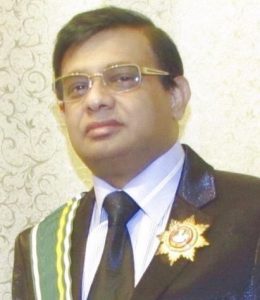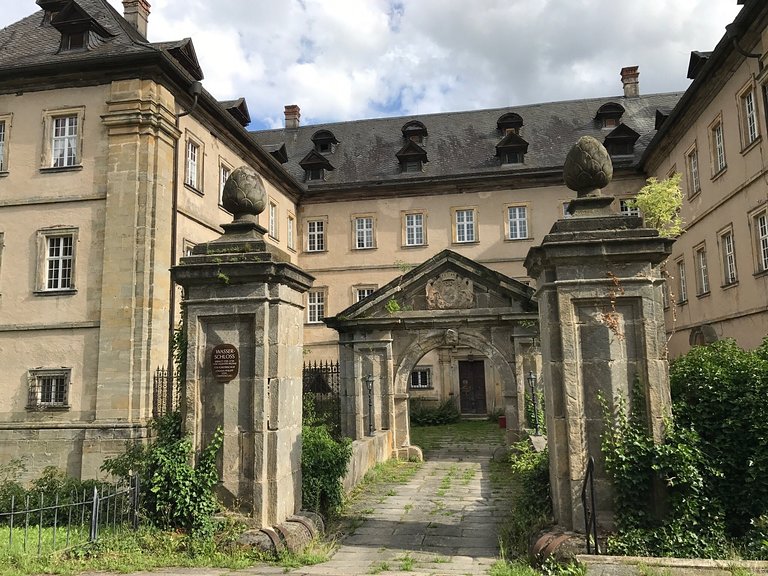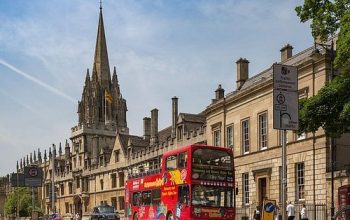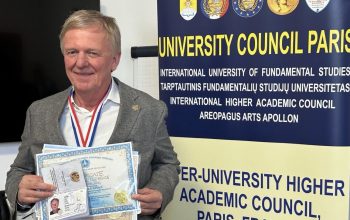
A Member of a Royal Dynasty: Professor Shanti Jayasekara, Count von Gereuth
The History of the Hohenzollern House
On August 20, 2010 in St. Petersburg, Professor Shanti Jayasekara Pushpa Kumara was awarded the family title of Count von Gereuth. Prince George Friedrich Ferdinand, a special guest, was the one who awarded Professor Shanti Jayasekara the honorary title of Count. In addition, Professor Shanti Jayasekara signed a deed of ownership of a part of the castle, and he obtained the passport of a member of the Royal Society, which endows him with privileges at the international level.
Georg Friedrich von Hohenzollern
Georg Friedrich Ferdinand, Prince of Prussia (born June 10, 1976) is a German businessman, a current head of the Prussian branch of the House of Hohenzollern, the former ruling dynasty of the German Empire and the Kingdom of Prussia. He is the great-great-grandson and historical heir to Wilhelm II, the last German emperor and the king of Prussia, who abdicated the throne and went into exile right after Germany’s defeat in World War I in 1918.
Georg Friedrich is the only son of Prince Louis Ferdinand of Prussia (1944–1977) and Countess Donata of Castel-Rüdenhausen (1950–2015). After his father died in 1977 in a military car accident, Georg Friedrich spent most of his youth in the care of Louis Ferdinand, his paternal grandfather. He attended middle schools in Bremen and Oldenburg and completed his education at Glenalmond College near Perth, Scotland, where he took the A-level exams. Georg Friedrich holds a degree in Business Economics of the Freiberg University of Mining and Technology.
Georg Friedrich works for a company that specializes in helping universities promote their innovations. He also managed the Fund of the Princess of Prussia Kira, founded by his grandmother, Grand Duchess Kira of Russia in 1952, which is now run by his spouse. He owns two-thirds of the share of his family’s original residence, the Hohenzollern Castle, and the other share belongs to the head. He also owns an island in the Great Lake Plön. In 2017, he founded a beer brand called Kgl. Preußische Biermanufactur (Royal Prussian Brewery) producing a Pilsner brand called Preussens.
Prince Georg Friedrich continues to pursue compensation for land and palaces in Berlin confiscated from his family, a court claim initiated in March 1991 by his grandfather Prince Louis Ferdinand of Prussia under the Compensation Act (EALG).
Georg Friedrich succeeded his grandfather, Louis Ferdinand, as a head of the Royal House of Prussia, a branch of the House of Hohenzollerns, on September 26, 1994. He claimed that he had learned to appreciate the history and responsibility of his heritage in the time spent with his paternal grandfather, who often told him anecdotes from the life in exile of his own grandfather, the last German Kaiser, Wilhelm II.
His position as a sole heir to his grandfather’s estate was disputed in the court by his uncles, Friedrich Wilhelm and Michael, who filed a lawsuit claiming that despite their renunciation of dynasties during their marriage, the loss of inheritance based on the choice of spouse was discriminatory and unconstitutional. Initially his uncles succeeded, the District Court of Hechingen and the District Court of Stuttgart ruled in their favor in 1997 on the grounds that the requirement to marry was “immoral”. However, the German Federal Court overturned the original rulings in favour of Georg Friedrich’s uncle, and the case was remitted to the courts of Hechingen and Stuttgart. This time, both courts ruled in favor of Georg Friedrich. His uncles then filed a case with the German Federal Constitutional Court, which overturned previous court rulings in favor of Georg Friedrich. On October 19, 2005, the German District Court ruled that Georg Friedrich was indeed the primary heir to his grandfather Louis Ferdinand (who was the main beneficiary of the trust created for the estate of William II), but also concluded that each of Louis Ferdinand’s children was entitled to a share Prussian inheritance.
House of Hohenzollerns
The family originated in the vicinity of the city of Hechingen in Swabia during the 11th century and got its name from the Hohenzollern castle. The first ancestors of the Hohenzollerns were mentioned in 1061. The various branches of the Hohenzollern Dynasty split into two branches: the Catholic Swabian and the Protestant Franconian, which later became the Brandenburg-Prussian. The Swabian “branch” of the dynasty ruled the principalities of Hohenzollern-Hechingen and Hohenzollern-Sigmaringen until 1849, and also ruled Romania from 1866 to 1947. The Margrave of Brandenburg and the Duchy of Prussia were in union after 1618, and in fact were a single state called Brandenburg-Prussia. The Kingdom of Prussia was created in 1701, which ultimately led to the unification of Germany and the creation of the German Empire in 1871, when the Hohenzollerns were hereditary German emperors and Prussian kings.
After World War I In 1918, the history of the Hohenzollern dynasty as a ruling family ended. The defeat of Germany in the First World War led to the revolution. The Hohenzollern dynasty was overthrown, after which the Weimar Republic was created, ending the German monarchy. Georg Friedrich, Prince of Prussia, is the current head of the royal Prussian line, and Karl Friedrich was the head of the princely Swabian line.
Zollern, since 1218, was a district of the Holy Roman Empire. Later, its capital was Hechingen. The Hohenzollerns named their estates after the aforementioned castle in the Swabian Alps. This castle is located on the 855-meter-high Hohenzollern mountain. It belongs to this family today. The dynasty was first mentioned in 1061. According to medieval chronicler Berthold Reichenau, Burkhard I, Count Zollern (de Zolorin) was born before 1025 and died in 1061. In 1095, Count Adalbert of Zollern founded the Benedictine monastery of Alpirsbach, located in the Black Forest. The Zollerns received the title of princes from Emperor Henry V in 1111. Loyal vassals, as loyal vassals of the Swabian dynasty of the Hohenstaufen, were able to significantly expand their territory. Count Frederick III (c. 1139 – c. 1200) accompanied the Emperor Frederick Barbarossa on a campaign against Henry the Lion in 1180, and thanks to his marriage, he was awarded the Nuremberg Emperor Henry VI in 1192. Around 1185, he married Sophia Raabskaya, daughter of Conrad II, Burgraf of Nuremberg. After the death of Konrad II, who left no male heirs, Frederick III was granted Nuremberg as Burgraf Frederick I.
In 1218, the title of burgraff passed to the eldest son of Frederick Konrad I, he became the progenitor of the Franconian branch of the Hohenzollern dynasty, which acquired the Brandenburg electorate in 1415. The oldest Franconian branch of the dynasty was founded by Conrad I, Burgraf of Nuremberg (1186–1261). The family supported the rulers of the Hohenstaufen and Habsburg dynasties, the emperors of the Holy Roman Empire, during the 12-15 centuries, in return being awarded a number of territorial allotments. Starting in the 16th century, this branch of the family became Protestant and decided to expand further through dynastic marriages and the purchase of surrounding lands. Further history after the death of John III on June 11, 1420, the margraves of Brandenburg-Ansbach and Brandenburg-Kulmbach were briefly reunited under Frederick VI.
He ruled the unified margrave of Brandenburg-Ansbach after 1398. From 1420 he became Margrave of Brandenburg-Kulmbach. From 1411, Frederick VI became Governor of Brandenburg, and then Elector and Margrave of that state, as Frederick I. In 1411, Frederick VI, Count of Nuremberg, was appointed Governor of Brandenburg to restore order and stability. At a council in Constance in 1415, King Sigismund elevated Frederick to the rank of Elector and Margrave of Brandenburg. This is how the strengthening of the Hohenzollern dynasty in Germany began.
In 1701, the title of king in Prussia was granted to representatives of this family, and the Prussian duchy was not elevated to a kingdom within the Holy Roman Empire. From 1701, the titles of Duke of Prussia and Elector of Brandenburg were forever tied to the title of King of Prussia. The Duke of Prussia assumed the title of king, receiving the status of a monarch, whose royal territory lies outside the Holy Roman Empire, with the consent of Emperor Leopold I.
However, at first Frederick could not be a full-fledged “king of Prussia”, because part of the Prussian lands was under the suzerainty of the crown of the Polish Kingdom. In the era of absolutism, most monarchs were obsessed with the desire to imitate Louis XIV, the palace at Versailles became the object of envy. The Hohenzollern dynasty also had a magnificent palace. In 1871, the German Empire was proclaimed. With the accession of William I to the newly created German throne, the titles of King of Prussia, Duke of Prussia and Elector of Brandenburg were forever tied to the title of German Emperor. In fact, this empire was a federation of dualistic monarchies. Chancellor Otto von Bismarck convinced Wilhelm that the title of German emperor, who replaced the emperor of the Holy Roman Empire, would be extremely appropriate. The Road to War Wilhelm II set out to create a German navy capable of challenging British naval rule. The assassination of Archduke Franz Ferdinand in Austria on June 28, 1914 marked the beginning of the chain of events that led to the First World War. As a result of the war, the German, Russian, Austro-Hungarian and Ottoman empires ceased to exist. In this article you can see the pictures of the Hohenzollern dynasty, or rather its most prominent representatives.
In the abyss of oblivion in 1918, the German Empire was abolished and replaced by the Weimar Republic. Following the outbreak of the German Revolution in 1918, Emperor Wilhelm II and Crown Prince Wilhelm signed a document of abdication. In June 1926, a referendum on the expropriation of the property of the former ruling princes (and monarchs) of Germany without compensation failed, and as a result, the financial situation of the Hohenzollern dynasty improved significantly. Arbitration between the former ruling dynasty and the Weimar Republic made Cecilienhof Castle the property of the state, but allowed the former emperor and his wife Cecile to reside there. The family also owned Monbijou Palace in Berlin, Olesnica Castle in Silesia, Reinsberg Palace, Schwedt Palace and other property until 1945. After World War II since the abolition of the German monarchy, no claim by the Hohenzollerns to imperial or royal prerogatives has been recognized in Germany’s Basic Law on the Federal Republic of 1949, which guarantees the preservation of the republican form of government. The communist government of the Soviet occupation zone deprived all landowners and industrialists of property rights. The House lost almost all of its fortune, retaining several shares in various companies and the already mentioned Hohenzollern Castle in West Germany. The Polish government took into the possession the property of the Hohenzollerns in Silesia, and the Dutch government took over the Wies Doorne, the home of the emperor in exile. The Hohenzollern dynasty still exists, but only a shadow of its former greatness remains. However, after the reunification of Germany, the House of Hohenzollern was able to legally re-claim all of her confiscated property, namely art collections and palaces. Negotiations on refund or compensation for expropriation are still pending. The old palace of the emperors in Berlin is being rebuilt and is due to open in 2019. Berlin Palace and the Humboldt Forum are located in the center of Berlin.
Titles and Possessions
The head of the house is the titular king of Prussia and the German emperor. He also holds the historical title of Prince of Orange. Georg Friedrich, Prince of Prussia, current head of the Royal Prussian House of Hohenzollerns, was married to Princess Sophie of Isenburg. On January 20, 2013, she gave birth to twins, Karl Friedrich Franz Alexander and Louis Ferdinand Christian Albrecht, in Bremen. Karl Friedrich, the eldest of them, is the obvious heir. The Cadet Swabian branch of the House of Hohenzollern was founded by Frederick IV, Count of Zollern. The family managed three land plots in Hechingen, Sigmaringen and Haigerloch. Counts were elevated to princes in 1623. The Swabian branch of the Hohenzollerns is Catholic. Affected by economic problems and internal strife, the Counts of Hohenzollern, starting in the 14th century, found themselves under pressure from their neighbors, the Counts of Württemberg and the cities of the Swabian League, whose troops besieged and finally destroyed the family castle of the dynasty in 1423. However, the Hohenzollerns retained their estates with the support of their cousins from Brandenburg and the Habsburg Imperial House. In 1535, Count Charles I of the House of Hohenzollern (1512-1576) received the counties of Sigmaringen and Wehringen as imperial fiefdoms. In 1576, when Charles I, Count of Hohenzollern died, his ancestral land was divided among three Swabian branches.
Georg Friedrich and his Spouse
On January 21, 2011, Georg Friedrich announced his engagement to Princess Sophie of Isenburg (born March 7, 1978), whose father, Franz Alexander, Prince of Isenburg, is the head of the House of Isenburg, formerly the prince of the Holy Roman Empire. Princess Sophie studied business administration in Freiburg and Berlin and, at the time of their engagement, was working for a firm that offered consulting services for non-profit businesses. The civil wedding took place in Potsdam on August 25, 2011, and the religious wedding took place at the Peace Church in Potsdam on August 27, 2011, to commemorate the 950th anniversary of the founding of the House of Hohenzollern. The religious wedding was also broadcast live on local public television. The dinner, which was attended by many members of the German and European royal families, was held at the Orangery Palace in Sanssouci Park.
A descendant of Queen Victoria, George Frideric belonged to the line of succession to the British throne from his birth until his marriage in 2011. Because he married a Catholic under the 1701 Settlement Act, he was thus disqualified from the British line before the 2013 Crown Succession Act came into effect in 2015, which reinstated any inheritance rights of British monarchs that had previously stripped them of their right to enter into law marriage with Catholics. George Frideric is currently ranked 170th in line to the British throne.
Legal Ownership
In mid-2019, it became known that Georg Friedrich had filed claims for permanent residence for his family at the Cecilienhof, or in one of the other two former palaces of the Hohenzollerns in Potsdam, and also for the return of the family library, 266 paintings, the imperial crown and scepter, and the letters of the empress Augusta Victoria. This sparked public debate about the legitimacy of these claims and the role of the Hohenzollerns during and before the Nazi regime in Germany, in particular the involvement of Crown Prince Wilhelm.
In June 2019, the court rejected Georg Friedrich’s claim to return the Rheinfels castle to the Hohenzollern family. In 1924, the ruined castle was transferred to the city of Saint-Goar, provided that it was not sold. In 1998, the city handed over the ruins of a nearby hotel. In his case, it was argued that this is a violation of the will.
Titles and Styles
In 1919, the royal and noble families lost their privileges in Germany. In accordance with article 109 of the Weimar Constitution, later hereditary titles were to be transferred only as part of the surname. Styles such as “Majesty” and “Highness” were not retained.
Yuliya Kalko
Journalist, translator



